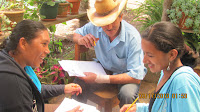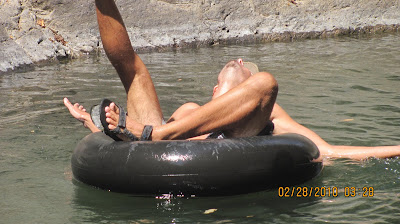
I arrived in Nicaragua with shirts in shades of charcoal gray, navy blue, and brown. While the sun fades the color of my shirts, it darkens the color of my skin. My arms and legs look like a topographical map, mountain ranges of insect bites and plant irritations are the norm. Though my blood runs sweet for the local
zancudos, my immune system can now tolerate well water from the farm and ice from the street, sold by the
cordoba from neighbor's front porches. Many Nica's, at first glance, curiously think I hail from Spain. Lately I have been impressed that I can make it through a conversation in a store and still get asked if I am Spanish! My 27th birthday on Thursday will mark four months that I've been in Nicaragua. Its hard to believe that all the experiences I have had here thus far are cosolidated into such a short period of time. Time passes in surges of change, uprooting and rerooting, followed by simple days of farm work, rice and beans, the company of my housemates, and and my trusty novel before bed.
January has proven to be a month of changes, as I returned from Ometepe to a grueling week of work and hurried preparations at the FUNCOS farm in unseasonably cool rains in anticipation of the SHI board of directors meetings. This was followed by my grand finale week with FUNCOS/ SHI accompanying the staff of Sustainable Harvest International from four Central American Countries and the U.S. on a weeklong
jornada, or conference. Now I am residing with three lovely women of very varied backgrounds (we are Swiss, American, Creol, and Mistizo) in beautiful barrio Santa Rosa, by day working with them side by side at the finquita in San Mateo, home to
Grupo Libertad Bluefields, a project that in so many ways feels like putting on an old pair of slippers; familiar, cozy, always a perfect fit. In this post, I would like to offer more detail about the type of agricultural projects I have been involved in, realizing as I look back through my posts, that most of my entries offer more about the culture and scenery of my current home, than the type of work I wake up to each day.

The day I arrived home from Ometepe, I found the FUNCOS tecnicos at the farm. We spent the week rushing to prepare the farm and office/ conference space for the arrival of the SHI board of directors and tecnicos from Belize, Honduras, and Panama. On our part, we worked to plant fruit trees in the reforestation area; citrus, cacao, coco, mango, papaya, and several trees that provide wood for harvest and construction. We planted the trees in the shade of other trees, that grow naturally in the damp jungle of the farm. We minimally disrupted the landscape, by using a sharpened stick to move aside the thick grass on the forest floor, then a smaller version of a metal hoe to dig out a circle of earth where we would plant each tree. A machete is used to clean the ground beforehand so that snakes pose minimal threat to us as we trample through.

In the gardens, where I had spent most of my time working, we finished our final double dug raised beds and began the work of clearing the second parcel of land, using two hoes to smooth every bump and ridge; very taxing work. I was frustrated that the vegetable seeds planted in the first beds never came up. I was sure they wouldnt emerge from the clay soil, with added sand, totally lacking in organic material. Though the farmer had prioritized the huerto over the compost, we had been maintaining our lombrihumus, or wormbin (fed only cow manure) for a longtime. I am not sure where the incredibly rich fertilizer ended up, but certainly not in the beds. Without greenhouses, it seems farmers here don't practice the art of seed starting in light, airy soil, like I am used to. My frustration mainly came from my inability to impress my doubts on the farmer, whose mild case of machismo did not allow for my input in such matters. I was appeased this week as tecnicos and regional directors approached me in hushed voices to ask my opinion about our work in the huerto, often noting that by this time, the start of the dry season, our beds should be budding with seedlings.

We worked from dawn to dusk each day and on Monday morning welcomed the guests. Monday and Tuesday we divided into work groups. The Belizeans taught us to construct a water catchment tank of cement. This tank would feed water into the water filtration system, a project led by the Panameans, in which layers of seasoned sand would filter water fed through pipes and tubes by gravity; the natural bacteria in the top layer of sand removing impurities from the water. The Hondurans set to work demonstrating how to set up a drip irrigation system, also carrying water from the tank. This system is most commonly used by organic farmers in the U.S. but proved new and exciting-- though expensive-- to the tecnicos of Nicaragua.

I had the opportunity to translate for a board member from New Hampshire, who led a workshop on how to set up a small solar panel, that we would install later in the FUNCOS office in San Pancho that is currently without electricity. The panels will power a laptop, recharge batteries and cell phones, and power the radio and lights. I wonder how this will shape the experience of the tecnicos in the office, which I remember as sharing the space of one room, passing the time when not working sitting in plastic chairs talking or staring off. At night we hunkered down on mats on the floor, listening to a battery powered radio by candlelight, usually falling asleep by 9pm. At the conclusion of one of our trips to the campo, we were invited by the tecnicos of a Spanish- funded organization doing similar work to our own, to a party of the
tecnicos (ours and theirs) at their office, equipped with internet and electricity. The excitement of having electricity for the first time in a month led us to get sloshed on Flor de Cana Rum playing Catalonian drinking games and dancing till the wee hours of night, completely forgetting that we would be waking at 4:30am to meet
pangas of saplings on the riverbank.

The office in San Pancho had been the perfect transition to carry us from the city into the
campo where living was very basic. There
tecnicos spend two or three weeks in a row visiting
productors from a home base. I learned that the tecnicos of the other three countries can travel to productors by bus and foot, or by dirt bike, where the Nica tecnicos travel by mule and foot over rough, muddy terrain, at times unpassable. The tecnicos visit each productor once every month or every other month, each time introducing a specific, predetermined topic, depending on the time of year. The demo farm has instituted many of the techniques that tecnicos have been teaching and demonstrating for years in the campo. To name a few:
diez pulagadas or square foot gardening with double dug rows, compost piles,
lombrihumus or worm bins fed with cow manure, shade growing fruit trees, composting latrinas. The greatest challenges of the productors are the poor, clay soils, heavy rainfall 9 months out of the year (these families grow for themselves only, as transporting products to market is impossible), access to affordable seeds, insects preying on fruit trees, and disease prevension, which often plague cacao trees. When asked, one tecnico mentioned that there aren't enough research programs in universities in the greater Central American region offering advice on pest prevention. Hopefully, with a new agroecology program at the national university on Managua, this will change.

After saying goodbye to the U.S. Board of Directors Tuesday night, we set out early the next morning to Rama, where the tecnicos would participate in a weeklong training. Staff took turns presenting on microfinance, environmental education, evaluation and goals, integrated pest management.

The educational highlight of the trip was a day long training in the production and management of cacao. We visited a farm where we had the opportunity to practice grafting trees, a difficult process of F1 reproduction of the tree, followed by a visit to a cacao cooperative where we saw a bit of the processing of cacao. I learned that Taza Chocolate, a small Somerville chocolate company, is set to begin buying cacao from SHI Belize producers this season.

In between all this exciting exchange of knowledge and lively discussion, we took nightly forays to the local discos around Rama, the Belizeans always leading the crew. At the discos, the ladies weren't given a minute's rest as we were pulled to our feet again and again by the older male coworkers, who were ecstatic to be in the company of such beatiful young women. On my part, I was delighted to dance among friends and coworkers, rather than be submitted to the usual Bluefields crowd. Though Rama is not the most enticing city to visit, it proved to be a great place for dancing; a city where East meets West, and the cowboys of the campo meet the urban village. Salsa, Merengue, Bachata, Reggaeton, Ranchero Mexicano, and the favorite reggae tunes of Bluefields (an incessant five song rotation.) We would return to our hotel rooms, our feet exhausted, in time to nap a bit before another packed day of workshops began.

For me, these two weeks represented the first time I had felt fully alive and free in Bluefields. On the farm, the nine year old would correct me if I washed the rice four times instead of three and the mother would always find my rubber boots and wash them inside and out before I had the chance. At my new home, my housemates often look over my shoulder while I make fried plantains. In a city that is so diverse, variety is not always welcome. Often I feel like I am bouncing between two worlds here, as the experience of living with a traditional family in the campo is very different than living and working with the Creol Community; both equally set in their ways, however. For Mistizo families, you either belong to the Catholic Church or the Evangelical Church and for Creol families, you might belong to the Moravian or Baptist church.

In Bluefields, you either make
gallo pinto with coconut or without and
platanos verde are cut and fried one way, while
platanos maduro are cut and fried another way. Stifling for someone who loves to experiment in the kitchen! The week that we welcomed the SHI board and staff to the farm, I believe many of my coworkers and host families saw me in a new light as I floated between them, the Creol/English speaking Belizeans, and the board members, with whom I could speak animatedly about my work here as well as the work I'd left behind in Boston, the program coordinator/ community organizer in me coming back for the first time since I'd arrived here.

I had been nervous about returning from Ometepe to Bluefields and had not been looking forward to my birthday. Leaving Boston where my life and job represented my passions and professional goals to come here had made me feel young in many ways, as I communicated like a 12 year old, 9 year olds tell me how to wash my clothes, 20 year olds try to pick me up on the street, and most people my age have more than one child (80% of babies are born to women under the age of 17.) Farmers tell me how to plant tomatoes, not stopping to ask how I would do it. And I am humbled again and again by coworkers and housemates. I am forever grateful to the family I lived with my first three months; for the experience of living and learning from them and their culture. In fact, I am headed there today, as two weeks is too long to stay away! However, homestays are not meant to last forever and I was more than ready to have a bit more control over my daily routine, my work schedule and inhabit a room with a door I can close that does not serve as a tool closet/ toxic waste storage. How timely these transitions have been; moving in with four wonderful women, ranging in age from 20 to 60. Berlin is three days my elder (we celebrated her birthday last night.) Nights are filled with interesting conversation rather than chess tournaments (my Spanish is improving in leaps and bounds.) At the finquita, I participate in the staff meetings, our small staff of four now perfectly complements each other. Randy enjoys the bigger construction projects on the farm and is eager to work with the humanure and cow manure/ worm bin operation while I am ecstatic to have responsibility over planning and planting our gardens, fields of beans, orchards of fruits trees, overhauling the compost; pairing my previous knowledge with the techniques and tools appropriately used by farmers here.

In just a few weeks we´ve filled all the beds with veggies and sprouting seedlings and will have greens to eat in a mere three weeks-- a VERY new concept to people here! It seems, I can look forward to my birthday, afterall (an opportunity to cook a delicious meal for friends with total reign over the kitchen!)
Stay tuned for more on my work with
Grupo Libertad Bluefields and my recent travels up the Caribbean Cost to the small fishing villages of the Miskitu, Garifuna, Rama, and Creol communities. Change will continue into February as I begin to wrap up my life on the Caribbean Coast and head Northwest to the lush green mountains and farming communities, a revoultionary stronghold and cooperative capital.
Now that I am writing to an audience that is deep in the throws of winter, I look forward to more correspondences and stories from Philly, Vermont, Boston and beyond!
postscript: You may not realize, but you can click on the pictures in these posts to get the full screen view. Makes the picture of cacao blossoming from the tree trunk look dazzling.
 When I discovered that this country devours cabbage with every meal and that the Northern region of Nicaragua has strong German influence, I thought, where is the sauerkraut? However, fermentation has made its mark on agriculture and food here in other ways. Fermentation in the North of Nicaragua plays two important roles: biofertilizante for our crops and the fermentation involved in processing coffee.
When I discovered that this country devours cabbage with every meal and that the Northern region of Nicaragua has strong German influence, I thought, where is the sauerkraut? However, fermentation has made its mark on agriculture and food here in other ways. Fermentation in the North of Nicaragua plays two important roles: biofertilizante for our crops and the fermentation involved in processing coffee.





 Throughout the months of March and April, I worked with the agriculture extensionist to prep a series of three workshops we would give as we transition from our first year of the
Throughout the months of March and April, I worked with the agriculture extensionist to prep a series of three workshops we would give as we transition from our first year of the 












































